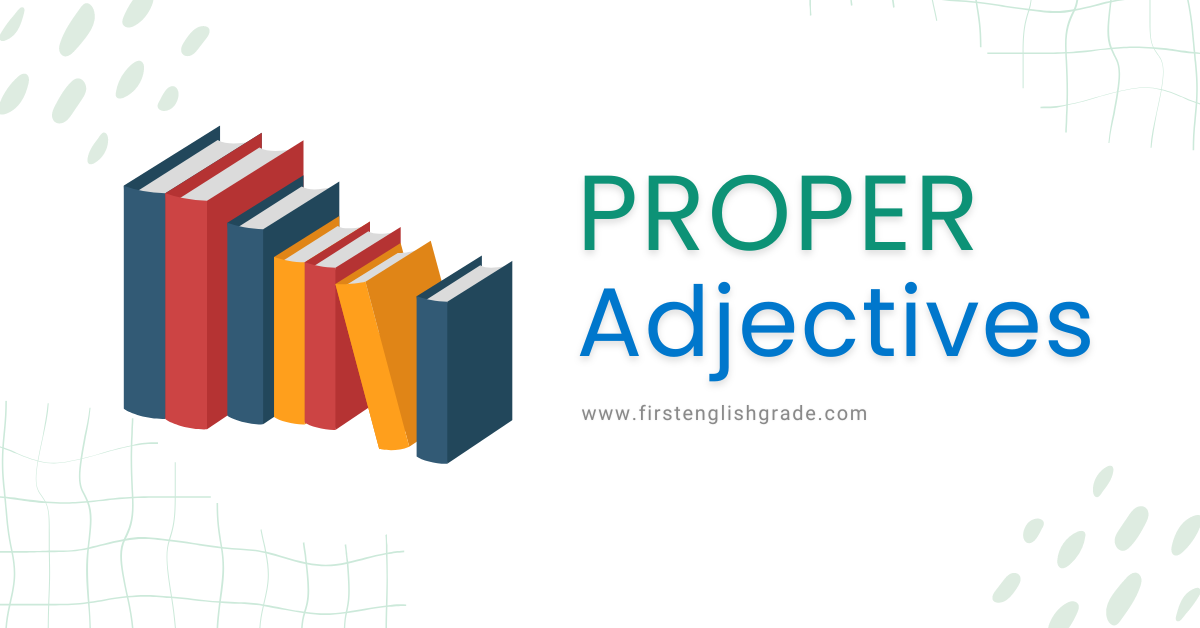Proper adjectives play a significant role in making the English language more specific and descriptive. Whether you’re a beginner or an English language enthusiast, understanding proper adjectives is essential for improving your communication skills.
What Are Proper Adjectives?
Proper adjectives are adjectives derived from proper nouns, which are the names of specific people, places, or things. These adjectives are used to provide more specific and precise descriptions, often indicating the nationality, origin, affiliation, or characteristics associated with the proper noun. Proper adjectives are typically capitalized to signal their special status and connection to a specific noun.
Examples:
- French cuisine (Proper adjective derived from the proper noun “France”).
- Spanish guitarist (Proper adjective derived from the proper noun “Spain”).
Examples of Proper Adjectives
Let’s explore examples of proper adjectives derived from various proper nouns:
- Indian
- Canadian
- French
- Russian
- Parisian
- Antarctic
- Japanese
- Spanish
- Egyptian
- Victorian
- Israeli
How to Form Proper Adjectives
Proper adjectives are born from proper nouns, which are names of specific people, places, or things. There are a few ways to form proper adjectives:
Capitalization
One of the key rules for proper adjectives is capitalizing the first letter. This capitalization signals that you’re talking about something specific.
Example:
- The Italian gelato was incredible. (Capital “I” indicates the proper adjective derived from “Italy.”)
Suffixes
You can transform proper nouns into proper adjectives by adding specific suffixes. Here are some common suffixes to keep in mind:
-ian:
- Canadian (from Canada)
- Australian (from Australia)
- Russian (from Russia)
- Indian (from India)
- Egyptian (from Egypt)
-ese:
- Japanese (from Japan)
- Taiwanese (from Taiwan)
- Burmese (from Myanmar)
- Portuguese (from Portugal)
- Sudanese (from Sudan)
-ish:
- Spanish (related to Spain)
- Turkish (related to Turkey)
- Swedish (related to Sweden)
- Danish (related to Denmark)
- British (related to the United Kingdom)
-ic:
- Antarctic (related to the region around the South Pole)
- Geographic (related to geography)
- Scientific (related to science)
- Historic (related to history)
- Economic (related to economics)
Using Proper Adjectives in Sentences
Now, let’s see how to use proper adjectives effectively in real-life situations.
Describing People: Proper adjectives are handy when you want to specify a person’s nationality, ethnicity, or origin.
- She’s a dedicated Italian chef who specializes in pasta dishes.
- Maria is a talented Indian guitarist.
- Picasso’s Spanish art has left an indelible mark on the world of painting.
Describing Places: When you’re talking about a specific location, proper adjectives help you make your description more vivid.
- The Venetian canals are a marvel of engineering and beauty.
- The New York skyline is impressive at night.
- We had a picnic in a beautiful Japanese garden.
- The Eiffel Tower is an iconic French landmark.
Describing Things: Proper adjectives can also add depth to your descriptions of objects.
- The Mona Lisa painting is renowned for its enigmatic smile.
- The Tesla electric car revolutionized the automotive industry.
- Her dress featured intricate Indian embroidery.
- This dress has a lovely Victorian design.
Notice how proper adjectives adapt to different contexts. In the first set of examples, they specify the nationality or origin of people. In the second set, they describe specific places, making our descriptions vivid and evocative. Finally, in the third set, proper adjectives add uniqueness to everyday objects, making them stand out in our descriptions.
Frequently Asked Questions (FAQs) about Proper Adjectives
Q1. What is a proper adjective?
A proper adjective is an adjective derived from a proper noun, which is the name of a specific person, place, or thing. It is used to provide specific and detailed descriptions, often indicating characteristics, nationality, origin, or affiliation related to the proper noun.
Q2. Can you give examples of proper adjectives related to people?
Certainly! Examples of proper adjectives related to people include “Italian,” “Canadian,” “Shakespearean,” “French,” and “Russian.”
Q3. What are some examples of proper adjectives related to places?
Examples of proper adjectives related to places include “Parisian,” “Antarctic,” “Japanese,” “Spanish,” and “Egyptian.”
Q4. How do you form proper adjectives?
Proper adjectives can be formed by capitalizing the first letter of the adjective, borrowing from proper nouns, or adding specific suffixes such as “-ian,” “-ese,” and “-ish,” to common adjectives.
Q5. Are there any irregular forms of proper adjectives?
Yes, some proper adjectives have irregular forms that don’t follow the capitalization or suffix rules. For example, “American” is an irregular form derived from “America.”
Q6. Can you provide more examples of proper adjectives in everyday sentences?
Certainly! Here are some more examples:
She visited a charming Italian village.
The Parisian fashion show was a hit.
The museum featured an impressive collection of ancient Egyptian artifacts.
He was known for his Shakespearean acting skills.
The conference explored various scientific topics.




